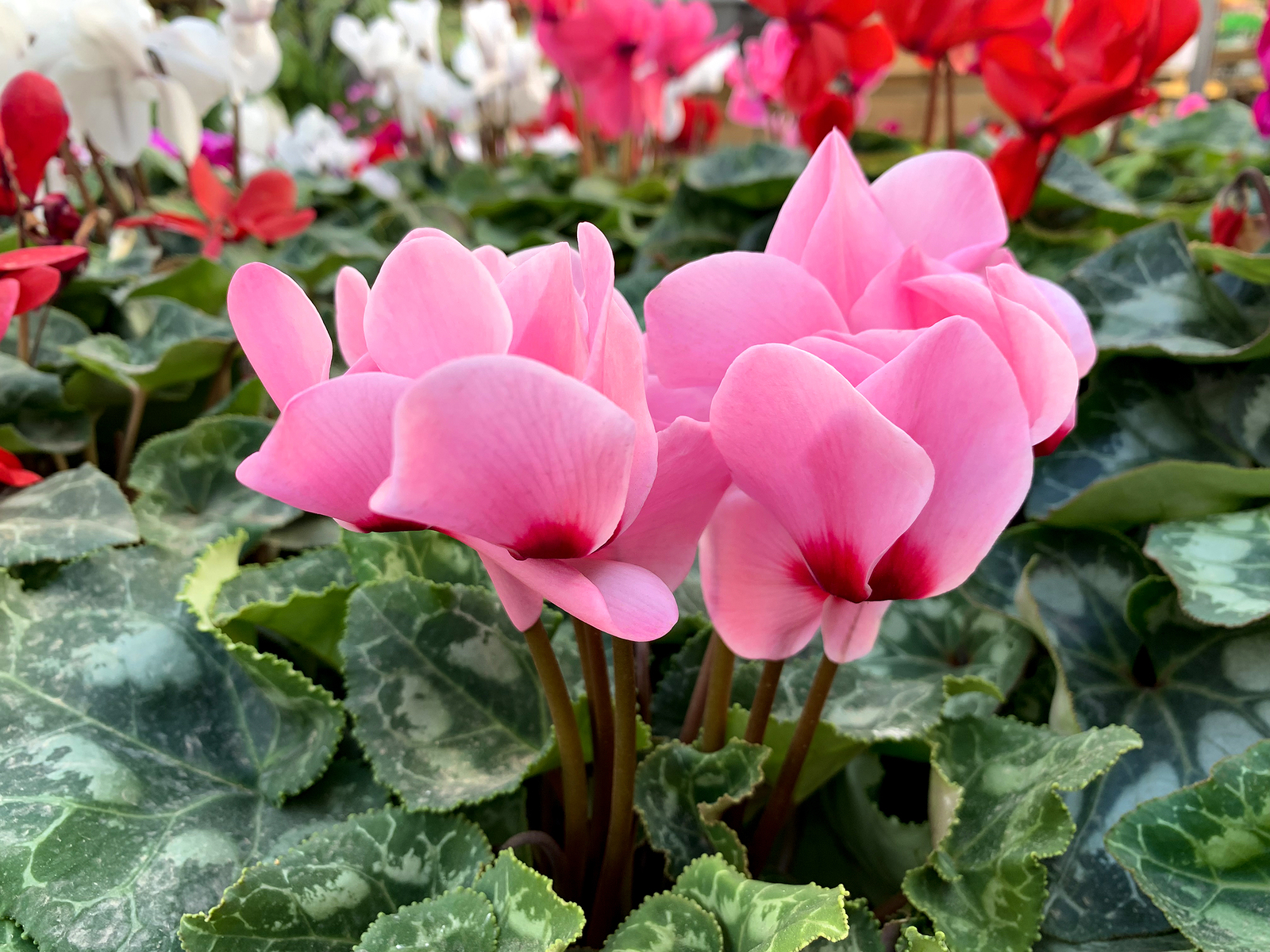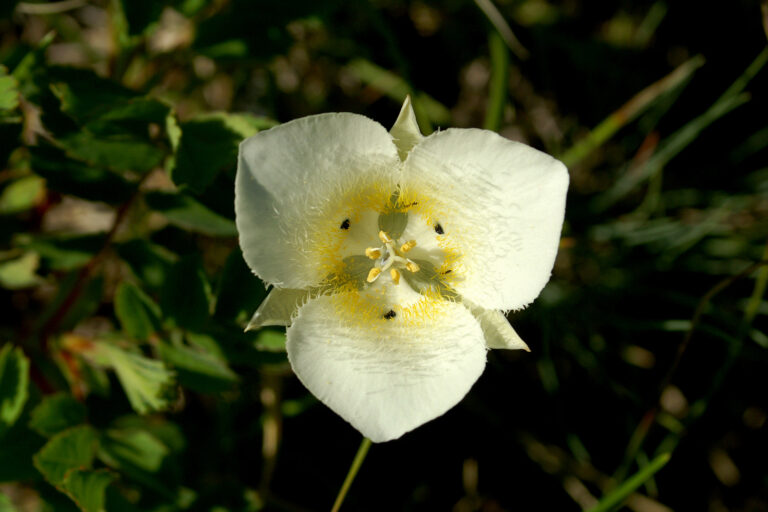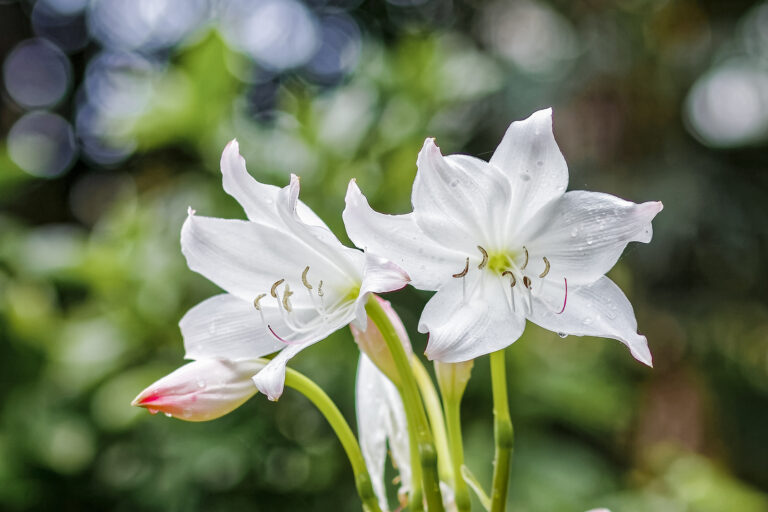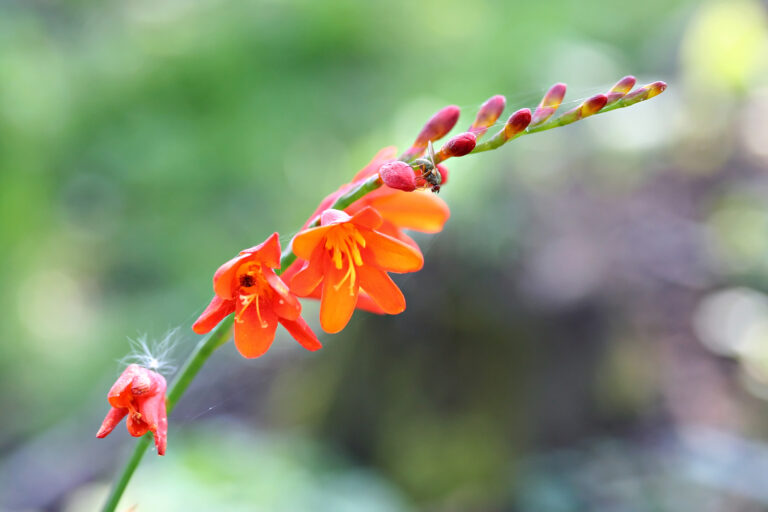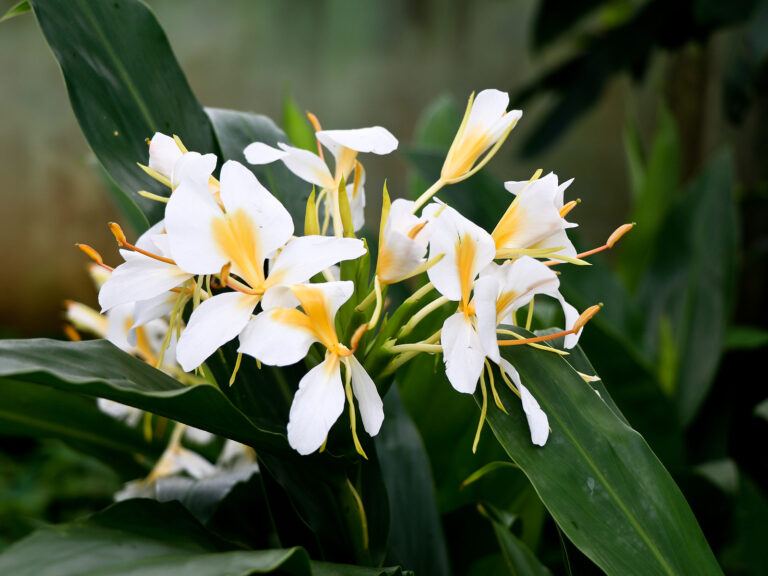How to Grow and Care for Cyclamen
Cyclamen is a charming flowering plant known for its unique, butterfly-like blooms and attractive heart-shaped leaves often patterned with silvery markings. It belongs to the genus Cyclamen, with species native to Europe, the Mediterranean region, and parts of western Asia. Cyclamen is particularly popular as a winter-blooming houseplant and as a ground cover in shaded gardens.
Description
- Flowers: Cyclamen blooms come in a variety of colors, including pink, red, white, purple, and bicolored. The flowers have gracefully reflexed petals that resemble shooting stars or butterflies.
- Leaves: The foliage is dark green with silver or light green marbling, adding ornamental appeal even when the plant isn’t flowering.
- Size: Most species and hybrids are compact, growing between 6–12 inches tall.
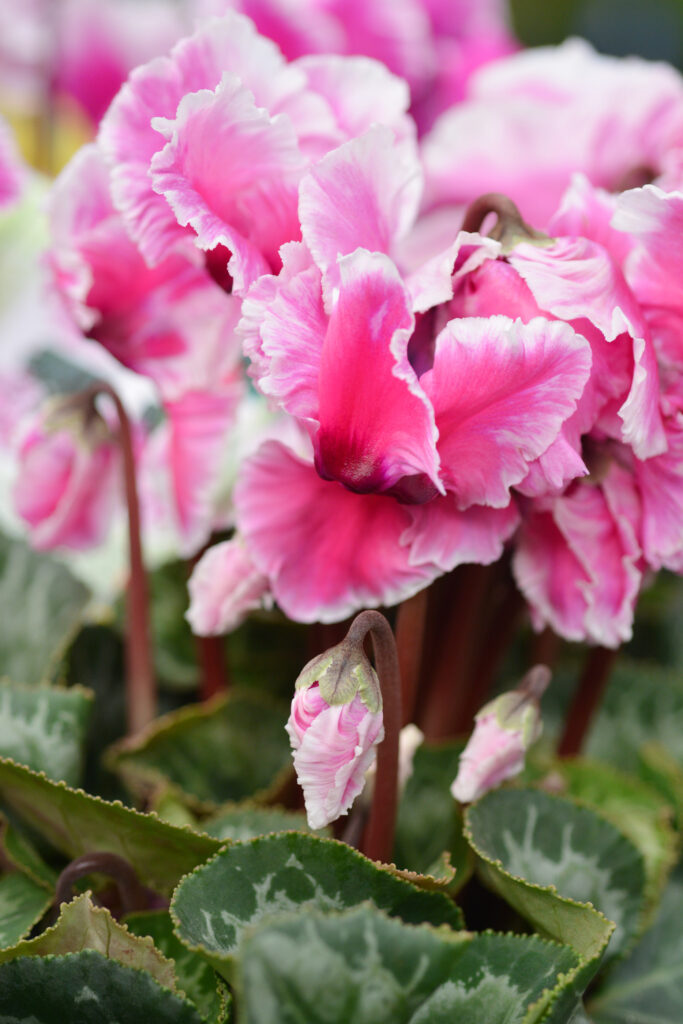
Growing Cyclamen Indoors
Cyclamen thrives as an indoor plant when given the right care:
- Light: Place the plant in bright, indirect light. Avoid direct sunlight, as it can scorch the leaves.
- Temperature: Keep the plant in cool temperatures (50–65°F or 10–18°C). Cyclamen dislikes excessive heat and thrives in cool environments.
- Watering: Water when the soil is dry to the touch but avoid overwatering, as this can cause root rot. Water from the base by placing the pot in a shallow tray of water to prevent water from soaking the crown.
- Humidity: Maintain moderate humidity by placing a tray of water with pebbles near the plant or using a humidifier.
- Dormancy: After flowering, the plant goes dormant. Reduce watering and allow the leaves to die back naturally. Resume regular care when new growth appears.
Growing Cyclamen Outdoors
Cyclamen can also be grown outdoors in mild climates, especially in shaded or woodland gardens:
- Climate: Hardy cyclamen species (Cyclamen hederifolium and Cyclamen coum) can tolerate outdoor conditions in USDA Zones 5–9. In colder zones, they need winter protection.
- Planting Location: Choose a spot with partial to full shade, such as under trees or along shaded borders. Ensure well-draining soil enriched with organic matter like compost or leaf mold.
- Planting: Plant tubers in late summer or early fall, about 1–2 inches deep, with the smooth side down and the “eye” or concave side facing up.
- Watering: Keep the soil moist during the growing season but reduce watering after flowering as the plant goes dormant.
- Companions: Cyclamen pairs beautifully with other shade-loving plants like ferns, hellebores, and hostas.
Key Tips for Success
- Avoid waterlogging; cyclamen prefer moist but not soggy soil.
- Provide excellent drainage, especially for outdoor plants to prevent rotting tubers.
- For indoor plants, remove spent flowers and leaves to encourage new blooms.
Cyclamen’s delicate beauty makes it an excellent choice for both indoor decoration and outdoor gardens!
More about Cyclamen
Cyclamen is a perennial bulb with rounded, silver-marble dark green leaves and blooms that are sometimes fragrant. Flowers can be white to pink and carmine-red. Purple blotches appear at the base of each petal in winter. Cyclamen goes dormant in the summer heat.
Cyclamen is a tuberous perennial. Heart-shaped leaves form at the base of the plant; they can be marbled in light green, gray, or silver on the upper surfaces. Flowers are held above the foliage. Flowers are nodding and their petals sweep upward.
Cyclamen is a colorful choice for winter indoor growing. It requires ample amounts of bright light when growing indoors. It’s best to water cyclamen growing indoors from the bottom, resting the container in a saucer of water, and letting the soil take its drink.
Cyclamen is a genus of about 19 species of tuberous perennials native to the Mediterranean east to Iran and south to Somalia.
How to grow Cyclamen indoors for the winter holidays
To grow cyclamen indoors for the holidays, place the plant in a cool spot with bright, indirect light, as it thrives in temperatures between 50 to 65°F (10-18°C). Keep the soil consistently moist but not soggy, watering from the base by setting the pot in a saucer of water for 10 to 15 minutes, allowing the roots to absorb moisture without wetting the crown. Cyclamen prefers high humidity, so placing the pot on a tray of pebbles and water can help maintain the right conditions. Fertilize every 3 to 4 weeks with a balanced, water-soluble fertilizer to encourage healthy blooms. Start caring for the plant early in the fall, and with proper care, it will provide beautiful, butterfly-like flowers in red, pink, purple, or white, just in time for the holidays.
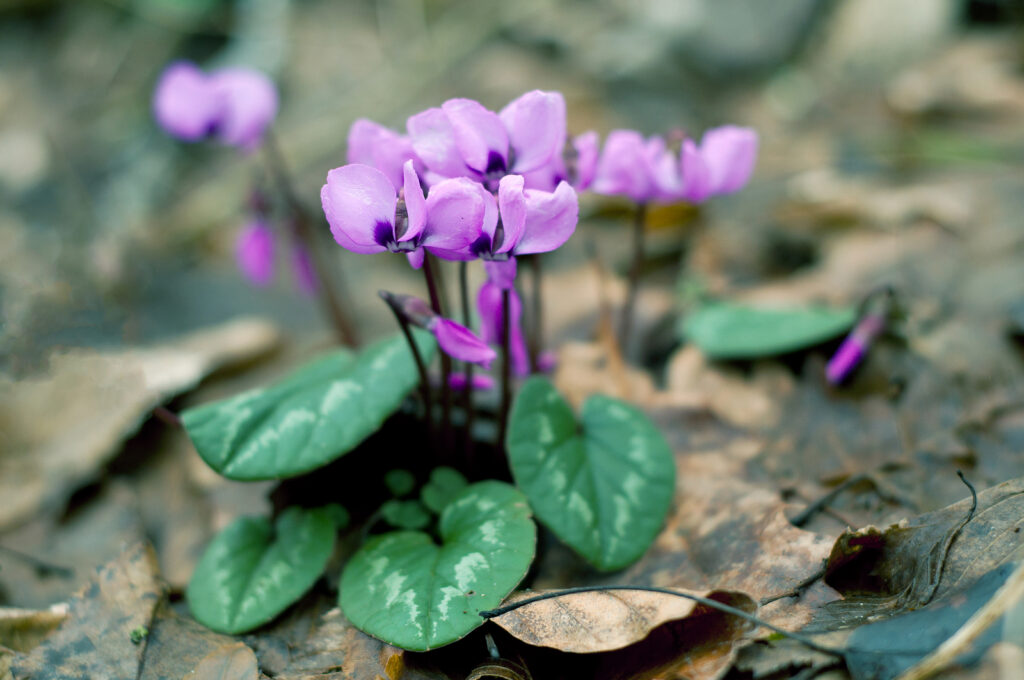
Seven tips for to using Cyclamen in the garden
Cyclamen can bring charm and elegance to your garden, especially in shaded or woodland areas. With their butterfly-like flowers and intricately patterned leaves, they add beauty during the cooler months when other plants may be dormant. Here’s how to use cyclamen effectively in your garden:
1. Choosing the Right Cyclamen for the Garden
- Hardy Cyclamen: Ideal for outdoor planting, particularly Cyclamen hederifolium (autumn-flowering) and Cyclamen coum (winter to early spring flowering). These species are more tolerant of colder climates and thrive in USDA Zones 5–9.
- Florist’s Cyclamen (Cyclamen persicum): Best used as seasonal bedding in milder climates (Zones 9–11), as they are less cold-hardy.
2. Design Ideas for Cyclamen in the Garden
- Woodland Gardens: Cyclamen thrives under deciduous trees or shrubs, where they can enjoy dappled light in spring and autumn and summer shade during dormancy.
- Shade Borders: Plant them at the front of shaded flower beds alongside other shade-loving plants like hellebores, ferns, and hostas.
- Rock Gardens: Hardy cyclamen work well in rock gardens, where their tubers benefit from excellent drainage.
- Naturalizing in Lawns: Cyclamen can naturalize beautifully when planted in grassy areas with good drainage. Their flowers will emerge before the grass begins actively growing.
- Container Gardens: Use cyclamen in pots or window boxes for seasonal displays. Pair them with other winter-interest plants like violas, primroses, or evergreen foliage.
3. Planting Cyclamen in the Garden
- Site Selection:
- Choose a location with partial to full shade, especially under deciduous trees or near shaded garden walls.
- Ensure well-draining soil to prevent tuber rot. Amending heavy clay soil with grit or compost is essential.
- Planting Depth:
- Plant tubers in late summer or early autumn.
- Place them 1–2 inches deep, with the concave side (the “eye”) facing up.
- Spacing:
- Space tubers about 6–12 inches apart to allow the plants to spread and naturalize over time.
4. Companion Plants for Cyclamen
Pair cyclamen with other shade-tolerant plants for a layered and visually appealing garden:
- Hellebores: Their blooms overlap with cyclamen, creating a winter-to-spring display.
- Snowdrops and Crocuses: These early bulbs complement cyclamen blooms beautifully.
- Ferns: Provide a delicate, contrasting backdrop for cyclamen’s bold leaves and flowers.
- Hostas: Add texture and interest during the summer months when cyclamen are dormant.
5. Seasonal Care for Cyclamen in the Garden
- Autumn and Winter:
- Cyclamen will bloom during the cooler months, adding interest to the garden. Deadhead spent flowers to encourage continued blooming.
- Spring:
- After flowering, allow the foliage to die back naturally as the plant enters dormancy. This helps the tuber store energy for the next season.
- Summer:
- Hardy cyclamen tolerate dry conditions during dormancy. Avoid watering or disturbing the tubers.
- Fertilizing:
- Apply a balanced, slow-release fertilizer in autumn and early spring to encourage healthy growth and blooms.
6. Long-Term Maintenance
- Cyclamen naturalize over time, forming clumps that return year after year.
- Every few years, lift and divide tubers during dormancy if the clumps become overcrowded.
- Protect plants from slugs and snails, which may feed on young leaves or flowers.
7. Seasonal Displays
For a seasonal pop of color, combine cyclamen with:
- Evergreens like boxwood or heuchera.
- Winter-blooming shrubs like camellias or mahonias.
Cyclamen’s delicate beauty and low-maintenance nature make it a valuable addition to any shaded garden, especially for enhancing year-round interest.
Get to know Cyclamen
- Plant type: Hardy or tender bulb
- Growing Zones and range: Zones 4 to 7 for hardy types, Zones 7-9 for tender types
- Hardiness: Cyclamen grows best when summers are relatively dry with cool nights. Indoors cyclamen grows best in temperatures between 60° and 72°F (16°-22°C) during the day and 40° and 60°F (4.5°-16°C) at night.
- Height and width: 3 to 12 inches (7.6-30cm) tall, 4 to 8 inches (10-20cm) wide
- Foliage: Heart-shaped, silver-marked, green leaves
- Flowers: Tulip-like or “shooting star”-shaped flowers formed by 5-lobed petals that are either smooth or frilled and swept back from a central ring; flowers appear on upward-pointing leafless flower stalks; flower colors are shades of red, rose, carmine, magenta, violet, pink or white.
- Bloom time: Spring or fall in cold winter regions; late autumn to early spring in mild-winter regions
- Uses: Containers outdoors in spring and fall, indoors in winter; in the garden group cyclamen in a dozen or more plants for best effect.
- Common name: Cyclamen
- Botanical name: Cyclamen
- Family: Primulaceae
- Origin: Mediterranean eat to Iran and south to Somalia
Where to plant Cyclamen
- Cyclamen grows best in partial shade; plant cyclamen under the shade of trees or shrubs.
- Grow cyclamen in humus-rich, well-drained soil, but moist soil.
- Growing indoors the potting medium must be very rich and moist at all times.
- Cyclamen prefers a soil pH of 7 to 7.5.
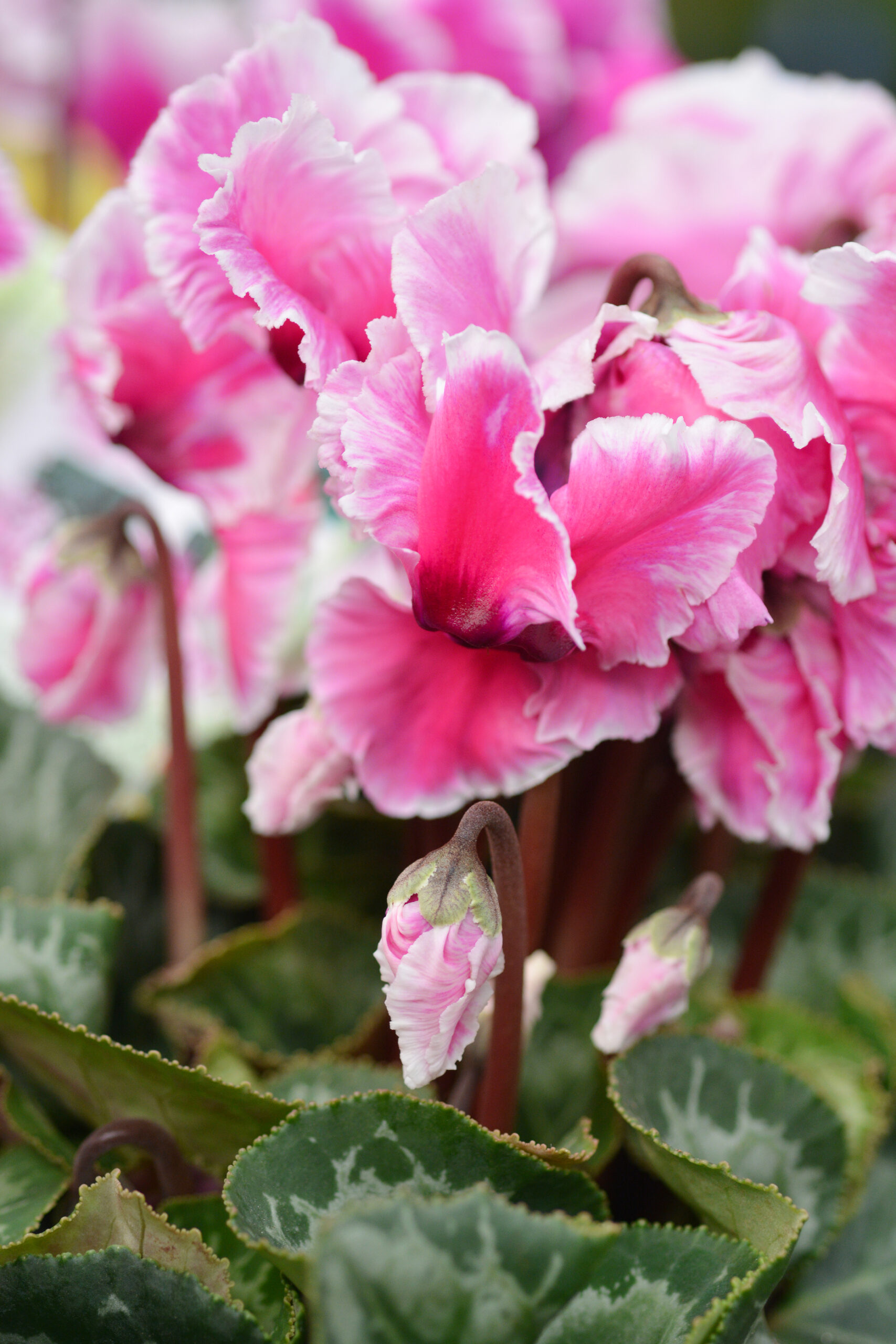
When to plant Cyclamen
- Set established cyclamen plants or tubers in the garden in spring or fall.
- Start seed indoors 8 weeks before the last frost.
- Start tuberous roots indoors 4 to 6 weeks before the last frost in spring.
- Sow seed outdoors after all danger of frost has passed; these plants will bloom the following year.
- Set plants or tuberous roots outdoors in their permanent location after all danger of frost has passed.
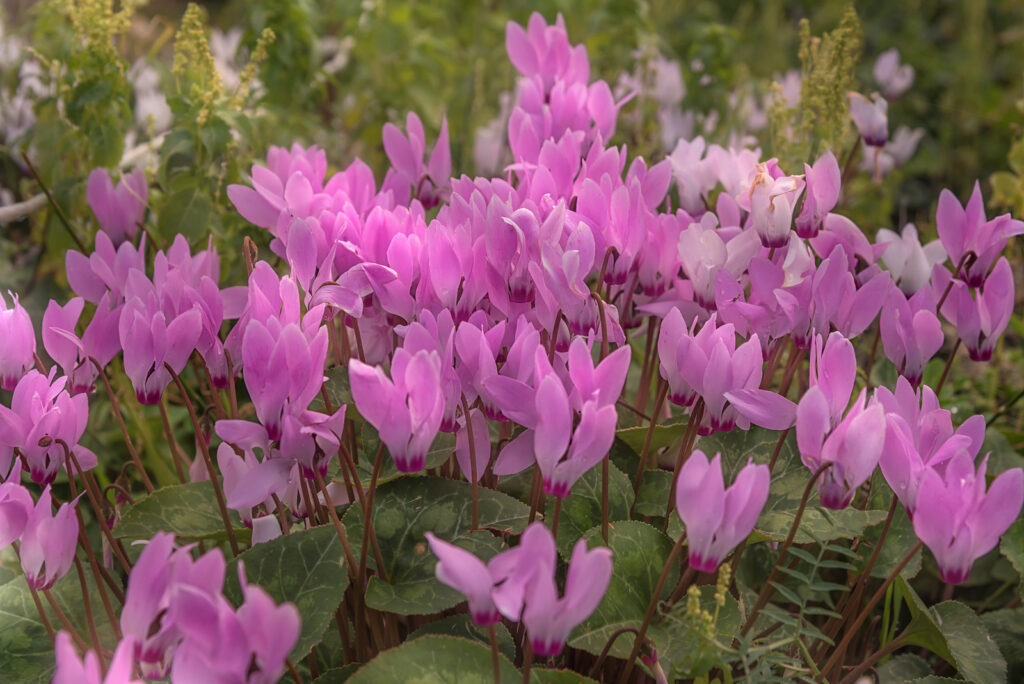
Planting and spacing Cyclamen
- Sow seed indoors in pots or six-packs filled with fresh seed starting mix. Cover the seed with 1/8 inch of soil.
- Keep seeds at 65° to 75°F (18°-24°C); seeds will germinate in 7 to 14 days.
- Grow seedlings in bright light or under fluorescent light.
- Start tuberous roots indoors with the crown up, showing slightly above the soil; start tuberous roots in pots 6 inches (15cm) deep or more.
- Set cyclamen tubers in the garden just below the soil surface. Mark planting sites to avoid disturbing them.
- Thin seedlings when they are a few inches high.
- Space cyclamen 4 to 8 inches (10-20cm) apart in their permanent location.
- Cyclamen growing in containers indoors need bright light and high humidity to survive.
How to water and feed Cyclamen
- Cyclamen needs ample moisture; keep the soil evenly moist but not wet.
- Do not allow water to fall into the crown of the plant during watering, as this may cause rot; bottom watering may help prevent this problem.
- Add aged compost to the planting bed before planting.
- When plants are growing, fertilize once a month; when they are blooming fertilize every two weeks.
- After the cyclamen has stopped blooming, gradually withhold water and stop fertilizing.

Cyclamen care
- Mulch cyclamen with 2 to 3 inches (5-7cm) of chopped leaves for winter protection.
- Spread 1 to 2 inches (2.5-5cm) of compost over planting beds when the plant becomes deciduous in winter.
- Plants need a cool, dry rest period in the summer to rebloom. To aid dormancy, put the plants outdoors in a shaded spot and turn the pots on their sides, water occasionally to keep them barely moist until new leaves begin to appear.
- Weed around cyclamen regularly to avoid competition from weeds.
Growing Cyclamen as a houseplant
- Cyclamen needs cool temperature, high humidity, and bright light to survive in the house.
- the potting medium must be very rich and moist at all times.
- Do not allow water to fall into the crown of the plant during watering; this may cause crown rot.
- Fertilize once a month when plants are growing; when plants are blooming, fertilize every two weeks.
- After the cyclamen has ceased blooming, gradually withhold water and stop fertilizing.
- When the foliage has turned yellow, let the plant dry out and store it in its pots in a dark, 45°F (7.2°C) area for three months. Then bring it back into the house and start watering to encourage new growth.
- Plants generally flower in winter and spring and rest over the summer when temperatures are high.
Cyclamen common problems
- Mice or squirrels may eat corms.
- Mold can be a problem when flowers and leaves stay wet.
- Cyclamen is susceptible to botrytis blight, spider and cyclamen mites, and thrips.
Cyclamen propagation
- If the tubers are large, they may be divided in early fall before new growth starts. Cyclamen may also be grown from seed.
- Divide cyclamen by separating corms without cutting them.
Cyclamen species
- Cyclamen cilicium. Autumn-blooming hardy cyclamen with twisted pink flowers and round leaves mottled with silver, grow to 3 inches (7.5cm) tall.
- C. coum. Hardy plant blooms in fall through early spring on 6-inch-tall plants; leaves are silver-green; flowers are shades of deep rose.
- C. creticum. Spring blooming species 2 to 3 inches (5-7.6cm) tall with white to pink 1-inch flowers.
- C. hederifolium. Hardy garden cyclamen to 4 inches (10cm) tall; rose or white flowers appear in late winter through very early spring, followed by round green leaves.
- C. persicum. Known as florist’s cyclamen; grows best around 60°F (15.6°C); may be difficult to grow outdoors. Some new hybrids bloom 8 months after planting seed; older types require 18 months to bloom; plants vary from 6 to 12 inches (15-30cm) tall with flowers up to 4 inches (10cm) long; some cultivars resist heat or cold better than others.
- C. purpurascens. Hardy species grow to 3 inches (7.6cm) tall, red-violet almost purple flowers are fragrant and bloom for weeks; evergreen silvery-green leaves
- C. repandum. Hardy spring-blooming cyclamen 4 to 6 inches (10-15cm) tall with dark green leaves spotted with gray-green; bears small fragrant magenta-pink flowers.
Cyclamen coum — Winter cyclamen
Winter cyclamen blooms for several weeks beginning anywhere from December to April, depending on the climate. It is dormant in summer. The rounded leaves are solid green or spotted silver with red-purple undersides. The very small ¼ inch flowers have swept-back petals over the foliage on leafless stalks. Blossoms may be purplish magenta, crimson, or white, with a purple blotch.
- Size: 3 to 6 inches tall.
- Light: Light shade.
- Soil and moisture: Humus-rich, well-drained soil; plentiful moisture during growth.
- Planting and propagation: Plant containers-grown plants in spring or fall; plant tubers during dormancy, smooth side up, 1 inch deep, and 6 to 8 inches apart.
- Special care: Best if undisturbed for years and allowed to self-sow. After the bloom ends, top-dress with an inch of compost or leaf mold. Do not divide; reproduce by seed. Endangered in the wild; purchase only nursery-propagated plants.
- Pest and diseases: Cyclamen mites serious; leaf spot so. Gray mold can be troublesome in humid weather.
- Climate: Zones 7-9; possibly to zone 5 with mulch or snow cover. Best where summers are dry and nights are cool.
- Cultivars: Various selections with silver-marbled leaves. ‘Album’: white flowers.
- Garden use: Locate where small plants and winter foliage can be appreciated in rock gardens, under shrubs, or along a path; naturalize under high-branched trees in woodland or shade gardens for winter ground cover.
Cyclamen hederifolium (C. neapolitanum) — Hardy cyclamen
Cyclamen hederifolium is a late-summer- to fall-blooming hardy cyclamen. It may not bloom in its first year or two, but mature tubers can produce up to 50 flowers at a time. Best planted where it will go undisturbed for a long time. Corms produce many 1-inch, dark-eyed pink or white flowers with swept-back petals. Silver-marbled leaves are heart-shaped–more pointed than winter cyclamen–measuring up to 5 ½ inches across.
- Size: 3 to 6 inches tall.
- Light: Light shade.
- Soil and moisture: Humus-rich, well-drained soil; plentiful moisture during growth.
- Planting and propagation: Plant container-grown plants in spring or fall; or plant tubers during dormancy, smooth side down with tops at soil surface, 6 inches to 1 foot apart.
- Special care: Best if undisturbed for many years and allowed to self-sow. After the bloom ends, top-dress with 1 inch of compost or leaf mold. Do not divide corms; the plant reproduces by seed.
- Pest and diseases: Cyclamen mites are serious. Gray mold can be troublesome during humid weather.
- Climate: Zones 7-9; possibly to Zone 5 with winter mulch or snow cover. Best where summers are relatively dry and nights are cool.
- Similar species: C. purpurescens, shade-loving, fragrant, ¼-inch pink to magenta flowers from midsummer to late summer.
- Garden use: Locate where can be seen along paths or in rock gardens, or naturalize in woodland or shade gardens.
Cyclamen frequently asked questions
Q: How do I grow cyclamen indoors?
A: Cyclamens are among the most difficult of all plants for the living room. Cyclamen needs cool temperature, high humidity, and bright light to grow and survive indoors. The ideal temperature is 40° to 50°F. Living room conditions are too warm and dry, still, you can keep the plant alive for a few weeks in the living room. Place the plant in a window with bright light and the potting mix is just moist.
Q: What causes cyclamen leaves to turn yellow indoors? The leaves started to yellow not long after I brought the plant home from the nursery.
A: A sudden change from a moist greenhouse to a dry, hot atmosphere in the house is the likely cause. Cyclamen should be kept well watered, and away from too much sunlight. An east window is best. Make sure the potting mix stays just moist but not soggy.
Q: How should I water cyclamen indoors?
A: If cyclamen are kept cool–40° to 50°F–they will not dry out quickly. If kept in a very warm room, watering freely and frequently may prolong the plant’s life by a week or two, but it will not take the place of a low temperature. Water from below, or at the edge of the pot keeps the soil moist but not soggy.
Q: How long must I let a pot of cyclamen soak in a pan or water to wet it thoroughly?
A: If the water in the pan is halfway up the pot and the soil is moderately dry, allow it to soak for 10 to 15 minutes, then stand in the sink to drain off the surplus.
Q: How often should I fertilize cyclamen?
A: When plants are growing, fertilize once a month; when plants are blooming, fertilize every two weeks. After the cyclamen has stopped blooming, gradually withhold water and stop fertilizing.
Q: What do I do when the leaves on my cyclamen have all yellowed and died back?
A: When the foliage has turned yellow, let the plant dry out then store it in a dark, 45°F place for three months. At the end of three months, bring it back into the house and start watering to encourage new growth. Plants generally flower in winter and spring and rest over the summer when temperatures are high.
Q: Can cyclamen be grown from seed?
A: Cyclamen seedlings are easy to start if the seed is sown thinly in mid to late summer. It’s best to simulate greenhouse conditions for 12 to 18 months. Plants like a good loamy potting soil. They want full light but not direct sunlight. Water carefully and keep humidity high. In the fall and winter, the temperature should not be greater than 55°F.
Related Articles:

